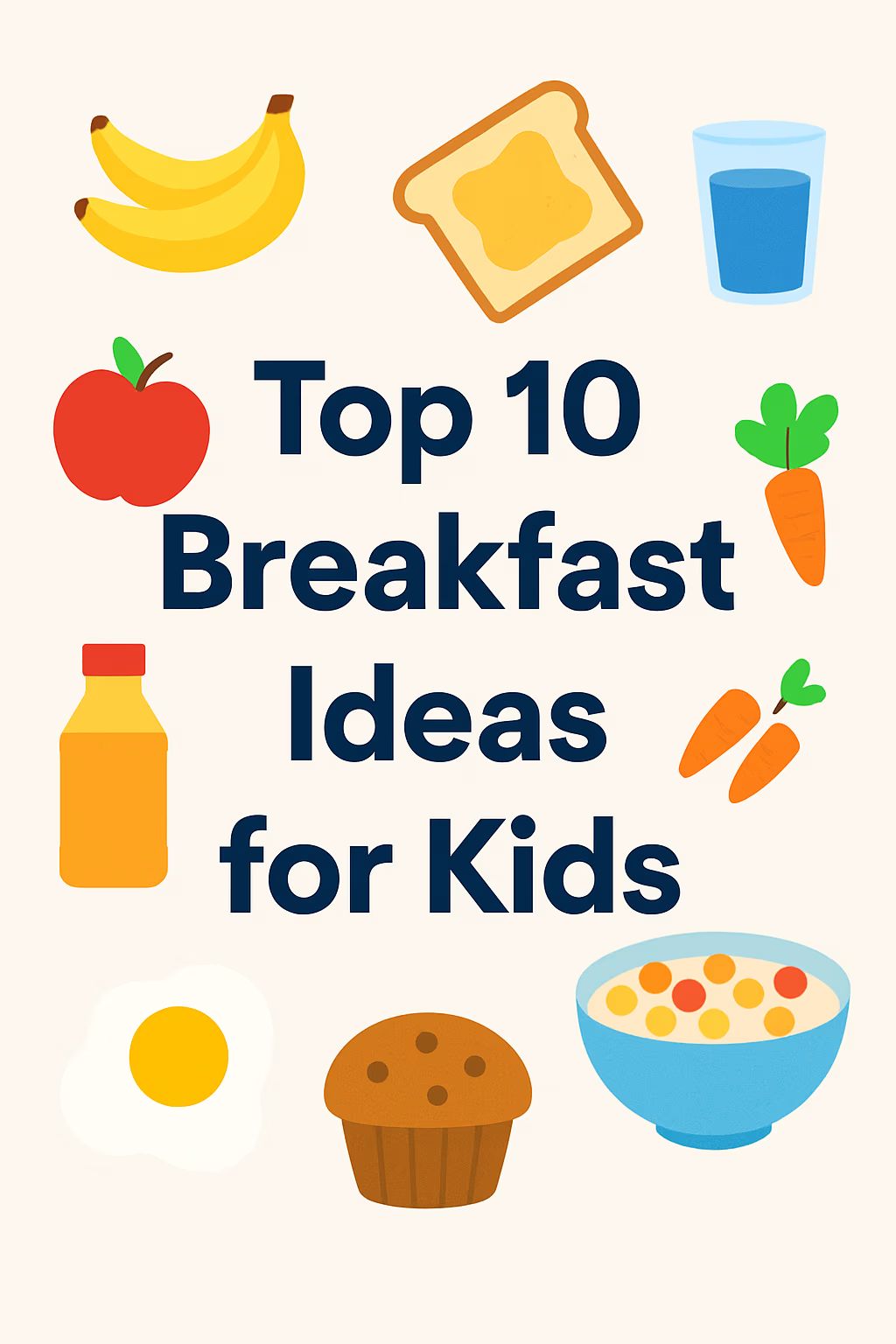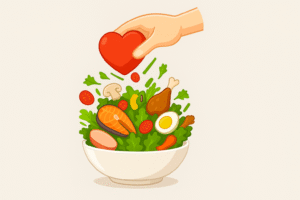🥣 Why a Healthy Breakfast Matters for Kids
Breakfast is more than just the first meal of the day—it’s the foundation for your child’s energy levels, learning, mood, and wellbeing. According to the British Nutrition Foundation (BNF), children who start their day with a balanced breakfast are more likely to stay focused in school, perform better academically, and maintain a healthy weight.
Yet for many busy families, mornings are a juggling act—getting dressed, packing school bags, beating the clock. In the rush, it’s easy to skip breakfast or rely on sugary, processed foods that leave children feeling tired, irritable, and hungry again by mid-morning.
But here’s the good news: healthy breakfasts don’t need to be complicated or time-consuming. With the right plan, you can serve quick meals that fuel your child’s brain, support growth, and encourage long-term healthy eating habits.
In this guide, you’ll find 10 quick and nutritious breakfast ideas designed specifically for UK families. Every recipe is child-friendly, aligned with the NHS Eatwell Guide, and suitable for children aged 2 to 12. Whether your child is a picky eater or always on the go, these ideas make mornings simpler—and healthier.
🍽️ What Makes a Healthy Breakfast for Children?
A nutritious breakfast gives children the energy and nutrients they need to concentrate, learn, and grow. According to the NHS Eatwell Guide, a well-balanced breakfast should include a variety of food groups that work together to fuel both body and brain.
Here’s what a healthy breakfast for kids should typically include:
- ✅ Whole grains – such as oats, wholemeal bread, or low-sugar cereals. These provide long-lasting energy and are rich in fibre to support digestion.
- ✅ Protein sources – like eggs, yogurt, beans, or lean meat. Protein helps build muscles, regulate hormones, and keep children feeling full for longer.
- ✅ Fruit or vegetables – rich in essential vitamins, minerals, and antioxidants. Aim for at least one serving of fruit or veg with breakfast.
- ✅ Dairy or fortified dairy alternatives – including milk, cheese, or plant-based options with added calcium and vitamin D for healthy bones and teeth.
- ✅ Healthy fats – such as avocado, nut-free seed spreads, or flaxseeds. These are essential for brain development and nutrient absorption.
It’s also important to limit added sugars and ultra-processed foods, which can lead to energy crashes and poor concentration. The British Dietetic Association advises parents to check food labels carefully and choose breakfast items with lower sugar and salt content whenever possible (source).
By combining these elements, you can ensure your child starts the day feeling energised, focused, and ready to learn—whether they’re heading to nursery, primary school, or just playing at home.
🕒 10 Quick & Healthy Breakfast Ideas for Busy Mornings
We get it—weekday mornings can feel like a mad dash. Whether you’re trying to find missing school shoes, pack a lunchbox, or just get everyone out the door on time, breakfast often becomes an afterthought. But it doesn’t have to be.
These 10 breakfast ideas are quick, nourishing, and perfect for children aged 2 to 12. Every option below is aligned with NHS guidance and can be whipped up in minutes—helping you start the day with less stress and more nutrition.
1. Overnight Oats with Berries & Chia
No time in the morning? Let the fridge do the work overnight. Just mix rolled oats with milk (or a fortified plant-based alternative), a spoonful of chia seeds, and a handful of berries. Leave it in a jar, and it’s ready to grab-and-go in the morning.
🥣 Why it’s great: High in fibre, calcium, and omega-3s—plus kids love the pudding-like texture.
2. Wholemeal Toast with Avocado & Boiled Egg
A classic combo that ticks all the boxes—healthy fats, protein, and complex carbs. Boil eggs in advance and store them in the fridge for extra speed.
🥑 Top tip: Add sliced tomatoes or a sprinkle of flaxseed for a nutrition boost.
3. Greek Yogurt Parfait with Banana & Granola
Layer up plain Greek yogurt, banana slices, and a handful of low-sugar granola. It’s fun, colourful, and packed with gut-friendly probiotics.
🍌 Quick hack: Let your child assemble their own—kids are more likely to eat what they help make.
4. Banana Oat Pancakes (2 Ingredients!)
Mash 1 ripe banana, mix with 2 eggs, and cook like mini pancakes. No flour, no fuss, just naturally sweet and fluffy goodness.
🥞 Perfect for: Weekends or freezer meal prep—make extra and freeze for later.
5. Scrambled Egg Wrap with Spinach
Scramble a couple of eggs, add a handful of spinach, and roll it all into a wholemeal wrap. It’s handheld, mess-free, and ready in under 10 minutes.
🌯 Bonus: Toss in some grated cheese or chopped tomato if your child likes extra flavour.
6. Fruit Smoothie with Oats & Sunflower Butter
For those mornings when your child just won’t sit down to eat, smoothies are a lifesaver. Blend milk, banana, oats, berries, spinach, and a spoonful of nut-free sunflower butter.
🥤 Nutrient win: It covers protein, fibre, iron, and vitamin C all in one glass.
7. Mini Veggie Frittatas
These are like little egg muffins—perfect for meal prep. Whisk eggs with some grated courgette, cheese, and sweetcorn, pour into muffin trays, and bake.
🧁 Make-ahead tip: Keep in the fridge for up to 3 days or freeze a batch for those really hectic mornings.
8. Cottage Cheese & Crackers with Apple Wedges
Need something simple and no-cook? Top wholegrain crackers with cottage cheese and serve with some sliced apples. It’s crunchy, creamy, and totally satisfying.
🍎 Allergy note: Swap in lactose-free soft cheese if needed.
9. Toasted English Muffin with Banana & Nut-Free Spread
Toast half a wholemeal English muffin and top it with a sunflower seed or oat-based spread (school-safe!) and banana slices.
🍌 Why it works: Gives slow-release energy, healthy fats, and potassium for brain and body power.
10. Hummus, Chicken & Carrot Wrap
A savoury option packed with protein and fibre. Just spread hummus on a wrap, add some cooked chicken slices and grated carrot, roll it up and slice into pinwheels.
🥕 Lunchbox-friendly too! Make an extra one and pack it for school.
These ideas are flexible—swap in what your child enjoys, and don’t worry about being perfect. What matters most is consistency, balance, and creating a calm start to the day.
📚 For more NHS guidance on healthy breakfast choices, visit: Healthy breakfasts for children – NHS
🧒 Support for Picky Eaters at Breakfast
If breakfast feels like a daily battle in your household, you’re not alone. Many children go through fussy phases—especially first thing in the morning when appetites are low and time is tight. But with a little patience and creativity, you can help even the pickiest eaters build better breakfast habits.
The NHS recommends a gentle, pressure-free approach when introducing new foods. The key is to make breakfast fun, familiar, and stress-free—while gradually adding variety over time.
Here are some practical, proven strategies to help your child enjoy a healthier start to the day:
🍽️ Make Food Look Fun
Use colourful plates, bento boxes, or fun-shaped cutters to make fruit, toast, or pancakes visually appealing. A playful presentation can go a long way in getting kids to take that first bite.
👅 Try the “One-Bite Rule”
Encourage your child to try just one bite of a new food—no pressure to finish it. Often, that small step is enough to reduce resistance and build curiosity.
❌ Avoid Pressure or Bribes
Don’t force your child to eat or reward them for finishing their food. This can lead to negative associations with mealtimes. Keep things calm, relaxed, and positive.
🧡 Pair New with Familiar
Offer new foods alongside something your child already enjoys. For example, serve a new fruit with their usual yogurt or add spinach to their favourite scrambled eggs.
🔁 Be Patient and Consistent
According to the NHS, children may need 10–15 exposures to a new food before they accept it. Keep offering small portions regularly without making a fuss if they say no.
👨👩👧 Be a Role Model
Children mimic what they see. If they see you eating and enjoying healthy breakfasts, they’re far more likely to follow your lead over time.
Picky eating doesn’t last forever—but the way you respond to it can shape your child’s long-term relationship with food. Keep mealtimes low-pressure, keep options open, and celebrate small wins.
📚 Useful link: NHS – Tips for Fussy Eaters
💧 Hydration in the Morning
Breakfast isn’t just about food—what your child drinks is just as important. After a full night’s sleep, their body needs fluid to rehydrate, support brain function, and kickstart digestion. Encouraging healthy morning hydration can improve energy, focus, and even mood throughout the day.
According to NHS guidance, most children need 6–8 cups of fluid daily, and breakfast is a great time to get a head start.
Here’s what to aim for:
✅ Best Drinks for Breakfast
- Water – still the best choice for daily hydration. Offer it first thing in the morning and keep it accessible throughout the day.
- Milk – semi-skimmed, 1%, skimmed, or fortified plant-based alternatives like oat or soy milk. These provide protein, calcium, and vitamin D.
- Diluted fruit juice – 1 part 100% fruit juice to 10 parts water, and only with meals. This protects teeth while offering a vitamin C boost.
🚫 Drinks to Avoid
- Sugary drinks – such as fizzy drinks, flavoured waters, or juice drinks, are high in sugar and can damage teeth.
- Caffeinated drinks – like tea or coffee, aren’t recommended for young children and may interfere with calcium absorption.
💡 Smart Hydration Habits
- Offer water before breakfast to stimulate appetite and digestion.
- Send your child to school with a refillable water bottle and encourage them to drink regularly.
- For variety, add sliced fruit (like lemon, cucumber, or berries) to water for a naturally flavoured alternative.
Starting the day well-hydrated helps your child feel alert, refreshed, and ready to learn. Combine good hydration with a balanced breakfast, and you’ve already set the tone for a healthier day.
📚 Learn more from the NHS: Water, drinks and your health
Final Thoughts: Start Their Day Right
Building a healthy breakfast routine doesn’t have to be perfect—and it certainly doesn’t need to be stressful. What matters most is consistency, balance, and offering real food that supports your child’s growth, learning, and wellbeing.
From overnight oats to mini wraps, the ideas in this guide are designed to save time, reduce fuss, and give your child the best possible start to the day. Whether you’ve got a fussy eater or a breakfast enthusiast, there’s always a way to make morning meals work for your family.
Small, manageable changes—like swapping sugary cereal for wholegrain toast or including one more fruit on the plate—can make a big impact over time. And by involving your child in food choices, planning, or prep, you’re not just feeding them well—you’re teaching skills and habits that last a lifetime.
🥣 Remember: It’s not about being perfect. It’s about showing up, offering variety, and keeping it simple. A healthy start each morning is one of the most powerful ways to support your child’s body and mind—today and into the future.
📚 For more guidance on children’s nutrition, visit the British Nutrition Foundation and NHS Healthy Eating for Children.



